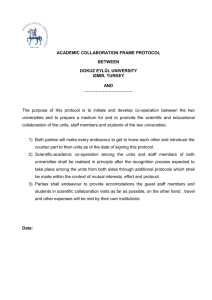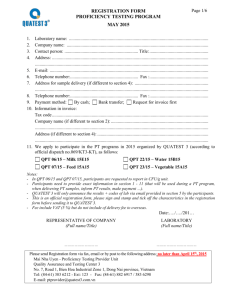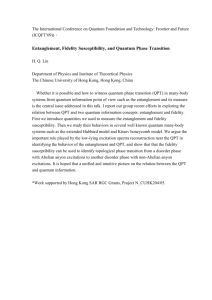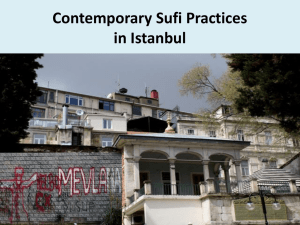effects of studying vocabulary enhancement activities on students
advertisement
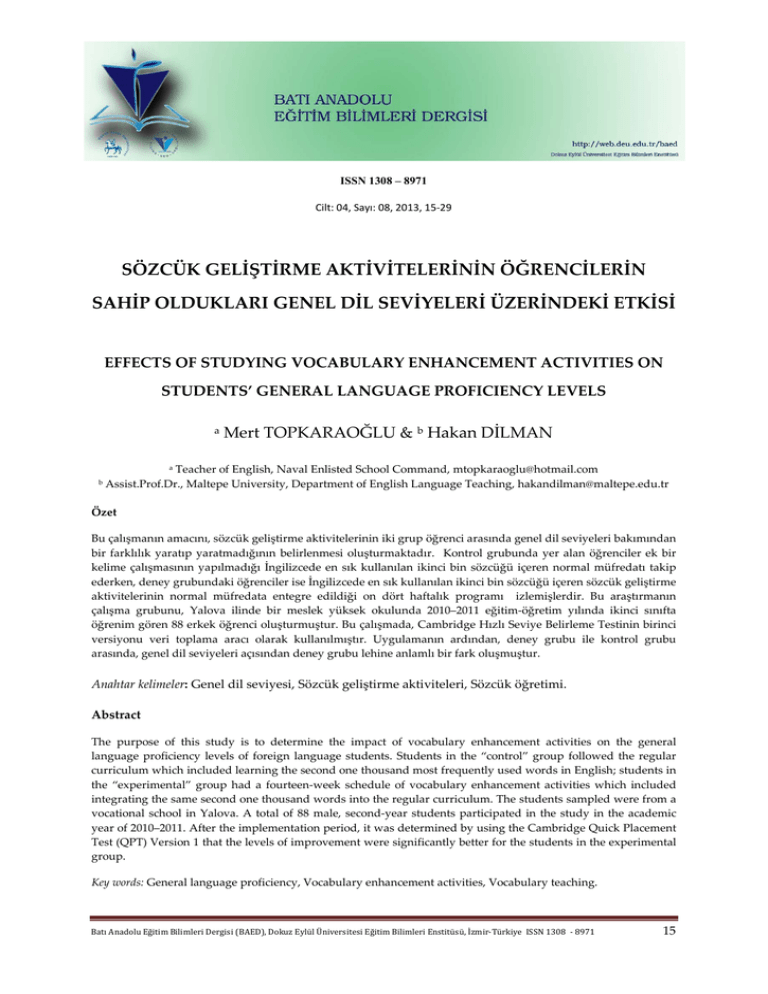
ISSN 1308 – 8971 Cilt: 04, Sayı: 08, 2013, 15-29 SÖZCÜK GELİŞTİRME AKTİVİTELERİNİN ÖĞRENCİLERİN SAHİP OLDUKLARI GENEL DİL SEVİYELERİ ÜZERİNDEKİ ETKİSİ EFFECTS OF STUDYING VOCABULARY ENHANCEMENT ACTIVITIES ON STUDENTS’ GENERAL LANGUAGE PROFICIENCY LEVELS a Mert TOPKARAOĞLU & b Hakan DİLMAN Teacher of English, Naval Enlisted School Command, mtopkaraoglu@hotmail.com Assist.Prof.Dr., Maltepe University, Department of English Language Teaching, hakandilman@maltepe.edu.tr a b Özet Bu çalışmanın amacını, sözcük geliştirme aktivitelerinin iki grup öğrenci arasında genel dil seviyeleri bakımından bir farklılık yaratıp yaratmadığının belirlenmesi oluşturmaktadır. Kontrol grubunda yer alan öğrenciler ek bir kelime çalışmasının yapılmadığı İngilizcede en sık kullanılan ikinci bin sözcüğü içeren normal müfredatı takip ederken, deney grubundaki öğrenciler ise İngilizcede en sık kullanılan ikinci bin sözcüğü içeren sözcük geliştirme aktivitelerinin normal müfredata entegre edildiği on dört haftalık programı izlemişlerdir. Bu araştırmanın çalışma grubunu, Yalova ilinde bir meslek yüksek okulunda 2010–2011 eğitim-öğretim yılında ikinci sınıfta öğrenim gören 88 erkek öğrenci oluşturmuştur. Bu çalışmada, Cambridge Hızlı Seviye Belirleme Testinin birinci versiyonu veri toplama aracı olarak kullanılmıştır. Uygulamanın ardından, deney grubu ile kontrol grubu arasında, genel dil seviyeleri açısından deney grubu lehine anlamlı bir fark oluşmuştur. Anahtar kelimeler: Genel dil seviyesi, Sözcük geliştirme aktiviteleri, Sözcük öğretimi. Abstract The purpose of this study is to determine the impact of vocabulary enhancement activities on the general language proficiency levels of foreign language students. Students in the “control” group followed the regular curriculum which included learning the second one thousand most frequently used words in English; students in the “experimental” group had a fourteen-week schedule of vocabulary enhancement activities which included integrating the same second one thousand words into the regular curriculum. The students sampled were from a vocational school in Yalova. A total of 88 male, second-year students participated in the study in the academic year of 2010–2011. After the implementation period, it was determined by using the Cambridge Quick Placement Test (QPT) Version 1 that the levels of improvement were significantly better for the students in the experimental group. Key words: General language proficiency, Vocabulary enhancement activities, Vocabulary teaching. Batı Anadolu Eğitim Bilimleri Dergisi (BAED), Dokuz Eylül Üniversitesi Eğitim Bilimleri Enstitüsü, İzmir-Türkiye ISSN 1308 - 8971 15 Introducing Comics as an Alternative Scientific Narrative in Chemistry Teaching INTRODUCTION Teaching foreign language vocabulary, especially English, is thought to be a tedious and a difficult process. Traditionally, vocabulary was seen as secondary in importance by traditional teaching approaches and methods (Harwood, 2002); learners can learn vocabulary on their own with implicit strategy, guessing and inferring from the context (Conzett, 2000). Language teaching has long regarded grammar and vocabulary as two parts and it has also long been thought that the former focused on structure, the latter on single words (Harwood, 2002). In other words, language learners tend to be required to master the basic structures of language first, and then to start building their L2 vocabulary (Nation, 2001). There was a time when language teaching and learning were viewed as a matter of controlling its grammar. Various methods such as Audio Lingual Method and Grammar Translation had mastery of structures as their main goal. Vocabulary development was regarded as an auxiliary activity. In these traditional approaches, grammar teaching was given utmost importance and considered as the main element of language teaching and communication. However, vocabulary is a core component of language proficiency, and it provides much of the basis for how well language learners listen, speak, read, and write (Richards & Renandya, 2002). In the same way, Wilkins (1972) emphasizes the significance of vocabulary with a motto “without grammar little can be conveyed; without vocabulary nothing can be conveyed” (p.111). Rubin (1982) postulates that unless a reader understands the meaning of words, he or she will have difficulty understanding what is read. She illustrated her point by giving the following example: "In the ravaged village there was a great amount of morbidity" (p.1). As she reasoned, a reader cannot understand the sentence without knowing the meaning of the two key words ravaged and morbidity. Second language learners are often conscious of the extent to which limitations in their vocabulary knowledge hamper their ability to communicate successfully in the target language (Read, 2004). From this perspective, it is clear that without an extensive vocabulary and strategies for learning new words, learners typically achieve less than their potential and may be discouraged from making use of language learning opportunities around them such as listening to the radio, listening to native speakers, using the language in different contexts, reading, or watching television (Richards & Renandya, 2002). 16 Batı Anadolu Eğitim Bilimleri Dergisi (BAED), Dokuz Eylül Üniversitesi Eğitim Bilimleri Enstitüsü, İzmir-Türkiye ISSN 1308 - 8971 Introducing Comics as an Alternative Scientific Narrative in Chemistry Teaching In regard to the importance of vocabulary learning in second language acquisition, Krashen (1989) stated: "A large vocabulary is, of course, essential for mastery of a language. Second language acquirers know this; they carry dictionaries with them, not grammar books, and regularly report that lack of vocabulary is a major problem" (p. 440). In the same way, Laufer and Hulstijin (2001) pointed out that almost all second language learners and teachers are well aware of the reality that learning a second language involves learning a large number of words. Nonetheless, there is no clear number of words that must be known by a L2 learner in order to be an efficient and effective language user in the target language. It is clear that those who have richness in their vocabulary knowledge can easily express their ideas and concepts in a more native-like manner because they have a better communicative competence in the target language (Hatch & Brown, 1995). So it is apparent that there is a close relation between the general language proficiency levels of the learners and vocabulary teaching. As the studies of vocabulary teaching and research develop, teaching vocabulary in ESL and EFL have been an area of interest in vocabulary research (Laufer, 1998; Lee, 2003; Lee & Muncie, 2006; Melka, 1997; Mondrea & Wiersma, 2004). These recent researchers revealed that students have difficulty in learning the vocabulary with traditional methods. From this perspective, vocabulary teaching in ELT has started to gain importance gradually and progressively. Many studies have been done on vocabulary learning in ELT, some of which are partially related to investigating the general language proficiency levels of students and the benefits of integrating vocabulary enhancement materials into the curriculum. Aksoy (2008) conducted a study to analyze the effects of phrasal verbs on speaking skills for students within the framework of the Lexical Approach; Bozkurt (2007) investigated the effectiveness of vocabulary notebooks on vocabulary acquisition; Ördem (2005) carried out a study whose aim was to find out whether teaching vocabulary via collocations would contribute to retention and use of foreign language. Ward (2009) employed a formative intervention to expose children to a variety of words in order to increase the size of their vocabularies. He repeatedly and supportively exposed children to words to increase the depth and semantic understanding of vocabulary. In the same way Chen (2009) examined how EFL students’ vocabulary knowledge and syntactic knowledge related to their reading comprehension; Tran (2011) conducted a study to explore EFL teachers’ perceptions of Batı Anadolu Eğitim Bilimleri Dergisi (BAED), Dokuz Eylül Üniversitesi Eğitim Bilimleri Enstitüsü, İzmir-Türkiye ISSN 1308 - 8971 17 Introducing Comics as an Alternative Scientific Narrative in Chemistry Teaching vocabulary acquisition and instruction and to identify their use of vocabulary strategies. Although vocabulary can arguably be considered the most important component in second language ability, it has been academically excluded from or limited within second language curricula and classroom instruction (Folse, 2004). Folse (2004) went on to notice that, ESL textbooks do not have vocabulary lists in the lessons or units or a vocabulary index at the back of the book. Moreover, as this author pointed out, vocabulary exercises can be found in reading books but are rarely found in grammar, speaking, listening, or writing books despite the significance of vocabulary in these areas. In this respect, it is assumed that this study which researches the impact of integrating the second one thousand most frequently used English words into the curriculum will contribute significantly to the literature in English Language Teaching. METHOD The aim of this study was to demonstrate whether additional vocabulary activities with the second one thousand most frequent words would increase the general language proficiency levels of students in foreign language classrooms. It was assumed that studying vocabulary with additional vocabulary activities would enhance general language proficiency of the students. For this study, a quasi-experimental design was formed similar to the study carried out by Nesselhauf (2005). The dependent variable for the experimental design is general language proficiency; for the independent variable, learning-teaching input is employed. The study sought to answer the following question: “Is there a significant difference in the general language proficiency levels between the students in the experimental group that had a vocabulary implementation schedule integrated into the regular curriculum and the control group that followed the classical methods used in the traditional vocabulary teaching?” Participants The study involved second-year students in the academic year of 2010–2011 from a vocational school in Yalova. A total of 88 male students participated in the study. The experimental group consisted of 43 and the control group consisted of 45 students. Turkish 18 Batı Anadolu Eğitim Bilimleri Dergisi (BAED), Dokuz Eylül Üniversitesi Eğitim Bilimleri Enstitüsü, İzmir-Türkiye ISSN 1308 - 8971 Introducing Comics as an Alternative Scientific Narrative in Chemistry Teaching was the only native language of the participants. The participating students ranged in age from 18 to 20. The school population consisted of students from different parts of the country with different ethnic and economic backgrounds. This vocational school was an institution that accepted students with scores between 210 and 230 from YGS–1 and YGS–2 in the nationwide, university entrance exams. Instruments To determine the effect of two different learning-teaching methods on language proficiency level, Cambridge Quick Placement Test (QPT) Version 1 was applied. QPT is a flexible test of English language proficiency developed by Oxford University Press and Cambridge ESOL to give teachers a reliable and time-saving method of finding a student’s level of English. The test can be used for learners of all levels and all ages. There are two versions available, a computer-based (CB) and a paper and pen (P&P). In this study paper and pen (P&P) version was applied. QPT (paper and pen version) takes approximately 30 minutes to administer and all the questions in the test are in multiple-choice format. The test consists of two parts; Part 1 (questions 1–40) is taken by all candidates; Part 2 (questions 41–60) is taken only by candidates who score more than 35 out of 40 on the first part. In the test, each item was scored as 1 point when the item was correctly answered; otherwise, it was scored as 0 point. The total scores obtained by the students can be ranged between 0 and 60. Correlation coefficient of the QPT was measured 0.91 for total test (Pollitt, 2010). Procedure The study took place during the second semester of 2010-2011 and lasted for fourteen weeks. Figure 1 describes the schematic representation of the design of the study. While the students in the control group followed the regular curriculum, the students in the experimental group had a vocabulary implementation schedule integrated into the regular curriculum. The English Language Teaching lessons were administered as follows: Students were exposed to 5 hours of English every week. They studied their main course books for an additional 3 hours. They are taught grammar rules, and they do grammar activities in these lessons. In addition, two hours of laboratory classes provide students opportunity for self-study. Students can listen to the reading passages in a native person’s voice, or check their own Batı Anadolu Eğitim Bilimleri Dergisi (BAED), Dokuz Eylül Üniversitesi Eğitim Bilimleri Enstitüsü, İzmir-Türkiye ISSN 1308 - 8971 19 Introducing Comics as an Alternative Scientific Narrative in Chemistry Teaching answers to grammar, vocabulary, or pronunciation exercises on the computer. It is compulsory for the students to attend these classes. Figure 1. The schematic representation of the design of the study Implementation in the Experimental Group Implementation in the Control Group Pretest (QPT) Pretest (QPT) Find The Synonym General Service List Verbs Match Them Up Smurfy Verbs Boost Up Your Vocabulary Traditional Vocabulary Learning Criss-Cross Find Them Up Fill In The Blanks Improve Your Vocabulary Unscramble These Words Posttest (QPT) Posttest (QPT) Implementation of the Vocabulary in Control Group The control group followed the regular school curriculum. The second one thousand most frequent words in English were also included within the books in this curriculum but there were no additional activities applied for their teaching. In 5 hours of English class every week, the students encountered many vocabulary words. The target words that were encountered in the main course and its different forms, such as verb form and adjective form were written on the board. Sometimes the students were asked to make sentences with the 20 Batı Anadolu Eğitim Bilimleri Dergisi (BAED), Dokuz Eylül Üniversitesi Eğitim Bilimleri Enstitüsü, İzmir-Türkiye ISSN 1308 - 8971 Introducing Comics as an Alternative Scientific Narrative in Chemistry Teaching words, and sometimes the sentences were made for the students. When the word was not difficult to understand in English, its meaning was said in the target language, but if it was difficult, the native language, Turkish was used. In this study, the researchers named all of these practices applied in the control group as “traditional method” shortly. Apart from these regular procedures, no vocabulary enhancement activities were performed for vocabulary teaching within the curriculum. Implementation of the Vocabulary in Experimental Group In the experimental group, students were exposed to approximately 80 words in four activities every week. Three of these activities, such as fill in the blanks, find the synonyms, and matching-ups took place in each week of the schedule. The fourth activity changed. For example, the fourth activity of the first week was a crossword puzzle named Smurfy verbs. In the second week, it was a “find-them-up” activity that was based on searching the words and marking them on different designs. The activities can be seen in Figure 1. In each “findthem-up” activity, different designs were created and presented to the students to increase their interest and motivation. This enhanced the retention of the newly learned vocabulary. For example in the “find-them-up 2” activity conducted in the fifth week, the activity was presented in a heart design; in the “find-them-up 3” activity in the seventh week, it was introduced in a clover design. With the help of these activities, the students were exposed to different aspects of word knowledge of the target words. Figure 2. Vocabulary Enhancement Activities Weeks Vocabulary Enhancement Activities Week 1 Find The Synonym, General Service List Verbs, Match Them Up, Smurfy Verbs Week 2 Boost Up Your Vocabulary, Criss-Cross, Find Them Up Week 3 Fill In The Blanks 2, Improve Your Vocabulary, Unscramble These Words Week 4 Criss-Cross 2, Fill In The Blanks 3, Find The Synonym 2, Match Them Up 2 Week 5 Boost Up Your Vocabulary 2, Find Them Up 2, Find The Synonym 3, Match Them Up 3 Week 6 Fill In The Blanks 4, Find The Synonym 4, Improve Your Vocabulary 2, Unscramble These Words 2 Batı Anadolu Eğitim Bilimleri Dergisi (BAED), Dokuz Eylül Üniversitesi Eğitim Bilimleri Enstitüsü, İzmir-Türkiye ISSN 1308 - 8971 21 Introducing Comics as an Alternative Scientific Narrative in Chemistry Teaching Week 7 Match Them Up 4, Unscramble These Words 3, Boost Up Your Vocabulary 3 Find Them Up 3 Week 8 Find The Synonym 5, Find Them Up 4, Improve Your Vocabulary 3, Unscramble These Words 4 Week 9 Match Them Up 5, Improve Your Vocabulary 4, Find Them Up 5 Unscramble These Words 5 Week 10 Improve Your Vocabulary 5, Boost Up Your Vocabulary 4, Criss-Cross 3 Find Them Up 6 Week 11 Improve Your Vocabulary 6, Boost Up Your Vocabulary 5, Criss-Cross 4 Find The Synonym 6 Week 12 Match Them Up 6, Boost Up Your Vocabulary 6, Criss-Cross 5 Unscramble These Words 6 Week 13 Fill In The Blanks 5, Fill In The Blanks 6, Smurfy Verbs 2, General Service List Verbs 2 Week 14 Revision 1 Improve Your Vocabulary, Revision 2 Boost Up Your Vocabulary, Revision 3 Criss-Cross, Revision 4 Find Them Up The researchers’ vocabulary activities were designed to reinforce the form and meaning connection. Studying vocabulary was not adequate alone; a recycle and revisit strategy (revision of the vocabulary of the previous week) was also administered throughout the implementation period. This activity enhanced learning and retention of the vocabulary. The researchers listed in the general class syllabus the words from the second 1000 words of the General Service List that were included in the vocabulary enhancement activities. After that, the draft of the fourteen-week schedule of the vocabulary implementation period, together with the activities of the first week that were incorporated, and the schedule was created. The vocabulary activities were not prepared in advance but were designed and prepared each weekend before the foreign language lessons. The experimental group was exposed to the fourteen-week intensive vocabulary schedule. The 14th week of the implementation period was used for general revision. The similar vocabulary activities were presented to the students in the revision week, but this time the least frequent 80 words of the 2000 words 22 Batı Anadolu Eğitim Bilimleri Dergisi (BAED), Dokuz Eylül Üniversitesi Eğitim Bilimleri Enstitüsü, İzmir-Türkiye ISSN 1308 - 8971 Introducing Comics as an Alternative Scientific Narrative in Chemistry Teaching were selected and included in the activities. This was done to check the overall learning and to improve the retention. Findings and Interpretations At the beginning of the implementation period, in order to determine whether there was a significant difference in the groups, QPT was conducted as a pretest. In order to determine whether there was a statistically significant difference between the total QPT Pre-Test results of the students in the experimental and control groups, independent samples t-test was conducted. When Table 1 was observed, no statistically significant difference was found between the total scores the students in the experimental and control groups had from the QPT Pre-Test (p>0.05). Based on the QPT Pre-Test scores, the general language proficiency levels of the students in the experimental and control groups were equal. Table 1. Comparison of the QPT pre-test scores of the students in the control and the experimental group Group Control Experimental N Mean 45 23.42 43 23.56 Standard Standard Deviation Error 5.01 0.75 5.06 t p -0.13 .900 0.77 A paired samples t-test was applied in order to determine whether there was a statistically significant difference between the students’ scores in the experimental group and control group before and after the vocabulary implementation period. When Table 2 is observed, it can be clearly seen that there is a statistically significant difference between the QPT Pre-Test and QPT Post-Test scores of the students in the control group (p<0.05). Based on the QPT Pre-Test/Post-Test scores of the control group, the classical approaches used in the traditional vocabulary teaching methods affected the general language proficiency of the students in a positive way. If Table 2 is observed, again it can be seen that there is a statistically significant difference between the QPT Pre-Test and QPT Post-Test scores of the students in the Batı Anadolu Eğitim Bilimleri Dergisi (BAED), Dokuz Eylül Üniversitesi Eğitim Bilimleri Enstitüsü, İzmir-Türkiye ISSN 1308 - 8971 23 Introducing Comics as an Alternative Scientific Narrative in Chemistry Teaching experimental group (p<0.05). Based on the QPT Pre-Test/Post-Test scores of the experimental group, the vocabulary implementation schedule integrated into the regular curriculum affected the general language proficiency levels of the students in a positive way. Table 2. Comparison of the QPT pre-test / post-test results of the groups Standard Group Test N Mean r t df p .69 -10.91 44 .000 .74 -19.96 42 .000 Error Pre-Test 45 23.42 0.75 Control Post-Test 45 29.49 0.65 Pre-Test 43 23.56 0.77 Experimental Post-Test 43 33.86 0.57 After the implementation period, in order to determine whether there was a significant difference in the groups, QPT was conducted as a post-test. To analyze the data, independent samples t-test was used (see Table 3). Table 3. Comparison of the QPT post-test scores of the students in the control and the experimental group Group N Mean Control 45 29.49 Experimental 24 43 33.86 Standard Standard Deviation Error 4.37 0.65 3.75 t p -5.03 .000 0.57 Batı Anadolu Eğitim Bilimleri Dergisi (BAED), Dokuz Eylül Üniversitesi Eğitim Bilimleri Enstitüsü, İzmir-Türkiye ISSN 1308 - 8971 Introducing Comics as an Alternative Scientific Narrative in Chemistry Teaching When Table 3 is observed, a statistically significant difference is found between the QPT Post-Test scores of the students in the experimental and control groups (p<0.05). With the vocabulary implementation schedule integrated into the regular curriculum, the general language proficiency levels of the experimental group students increased significantly more than for the control group students using the traditional vocabulary teaching methods. Discussion and Conclusions This study was conducted to determine whether studying vocabulary with additional vocabulary activities consisting of the second one thousand most frequent words would increase the general language proficiency levels of the students in foreign language classrooms. In respect to the QPT Pre-Test results, the general language proficiency levels of the students in the experimental and control groups were equal to each other. With regard to the QPT Post-Test scores, it was observed that there was a statistically significant increase in general language proficiency levels of the students both in the control group that studied vocabulary in traditional way within the curriculum and in the experimental group that studied vocabulary with enhancement activities in the 14-week implementation period. The reasons of the increase that were seen in the control group were as follows. The students in the control group also followed their usual curriculum in this fourteen-week long implementation period. Since the textbooks that are used in the institution are based on an eclectic method, they include basic vocabulary activities in every unit. As a result, an increase after a 14-week long implementation period was expected in the control group. To determine whether there was a statistically significant difference regarding the general language proficiency levels of the students in the experimental and control groups at the end of the intensive vocabulary implementation period, independent t-tests were conducted. The results showed that there was a statistically significant difference in favor of the experimental group. In light of these findings, it was concluded that studying vocabulary with additional activities consisting of the second one thousand most frequent words in English integrated into the regular curriculum increased the general language proficiency levels of the students much more than the traditional vocabulary teaching in the regular curriculum. This result is also consistent with the results of the studies carried out by Ördem (2005), Büyükkarcı (2006), and Aksoy (2008). As Meara claims “All other things being equal, Batı Anadolu Eğitim Bilimleri Dergisi (BAED), Dokuz Eylül Üniversitesi Eğitim Bilimleri Enstitüsü, İzmir-Türkiye ISSN 1308 - 8971 25 Introducing Comics as an Alternative Scientific Narrative in Chemistry Teaching learners with big vocabularies are more proficient in a wide range of language skills than learners with smaller vocabularies, and there is some evidence to support the view that vocabulary skills make a significant contribution to almost all aspects of L2 proficiency” (1996, p.3). In addition, Hwang and Nation (1989) postulated that when learners know the most frequent 2,000 words and all proper nouns they will reach about 90% coverage of newspaper texts and have a fairly competent language proficiency level. The results in this study showed that the students who studied vocabulary during the intensive fourteen-week vocabulary implementation period with various kinds of enhancement activities attained significantly higher scores in the receptive (Cambridge Quick Placement Test) vocabulary tests than the students who did not engage with this kind of learning period and were taught vocabulary in a traditional way. In addition, by learning the second one thousand most frequent words in English, the experimental groups students were shown to be more efficient and effective language users in the target language. To conclude, specifically prepared activities for vocabulary teaching within the curriculum proved to be valuable in helping language learners become talented and proficient language users in the target language. 26 Batı Anadolu Eğitim Bilimleri Dergisi (BAED), Dokuz Eylül Üniversitesi Eğitim Bilimleri Enstitüsü, İzmir-Türkiye ISSN 1308 - 8971 Introducing Comics as an Alternative Scientific Narrative in Chemistry Teaching References Aksoy, E. (2008). The Effects of Lexical Approach on Speaking Skills of Students Who Learn English As a Foreign Language. Unpublished M.A Thesis, Ankara University, Department of Curriculum and Instruction, Ankara. Bozkurt, N. (2007). The Effect of Vocabulary Notebooks on Vocabulary Acquisition. Unpublished M.A Thesis, Bilkent University, Graduate School of Education, Ankara. Büyükkarcı, K. (2006). Teaching Phrasal Verbs to Freshman Students at Universities by Using Communicative Approach. Unpublished M.A Thesis, Selçuk University, Institute of Social Sciences, Konya. Chen, K. (2009). An Explanatory Mixed Methods Study of EFL College Students’ Vocabulary Knowledge, Syntactic Knowledge, and Reading Comprehension. Unpublished PhD Dissertation, Texas A&M University Kingsville, College of Graduate Studies, Texas. Conzett, J. (2000). Integrating collocation into a reading and writing course. In M. Lewis (Ed), Teaching collocation: Further developments in the lexical approach (pp. 70 87). Hove, England: Language Teaching Publications. Folse, K. S. (2004). Vocabulary Myths: Applying Second Language Research to Classroom Teaching. Ann Arbor, MI: University of Michigan Press. Harwood, N. (2002) Taking a LA to teaching: Principles and problems. International Journal of Applied Linguistics, 12(2), 139–155. Hatch, E., Brown, C. (1995). Vocabulary, Semantics, and Language Education, Cambridge University Press, Cambridge. Hwang, K. & Nation, P. (1989). Reducing the vocabulary load and encouraging vocabulary learning through reading newspapers. Reading in a Foreign Language, 6(1), 323-335. Nesselhauf, N. (2005). Collocations in a learner corpus. U.S. : John Benjamins Publishing Company. Krashen, S. D. (1989). We acquire vocabulary and spelling by reading: Additional evidence for the input hypothesis. The Modern Language Journal, 73, 440-464. Batı Anadolu Eğitim Bilimleri Dergisi (BAED), Dokuz Eylül Üniversitesi Eğitim Bilimleri Enstitüsü, İzmir-Türkiye ISSN 1308 - 8971 27 Introducing Comics as an Alternative Scientific Narrative in Chemistry Teaching Lee, S. H. (2003). ESL learners’ vocabulary use in writing and the effects of explicit vocabulary instruction. System, 31(4), 537–561. Lee, S. H., & Muncie, J. (2006). From receptive to productive: Improving ESL learners’ use of vocabulary in a postreading composition task. TESOL Quarterly, 40(2), 295–320. Laufer, B. (1998). The development of passive and active vocabulary in a second language: Same or different? Applied Linguistics 19,(2), 255–271. Laufer, B., & Hulstijn, J. (2001). Incidental vocabulary acquisition in a second language: The construct of task-induced involvement. Applied Linguistics, 22(1), 1-26. Meara, P.(1996). “The dimensions of lexical competence”. Ed. G. Brown, K.Malmkjaer, and J. Williams. Performance and Competence in Second Language Acquisition. Cambridge: CUP : 35–53. Melka, F. (1997). Receptive vs. productive aspects of vocabulary. In N. Schmitt & M, McCarthy (Eds.), Vocabulary: Description, acquisition and pedagogy (pp.84–102). Cambridge, England: Cambridge University Press. Mondrea, J.-A., & Wiersma, B. (2004). Receptive, productive, and receptive + productive L2 vocabulary learning: What difference does it make? In P. Bogaards & B. Laufer (Eds.), Vocabulary in a second language (pp.79–100). Amsterdam: John Benjamins. Nation, P. (2001). Learning vocabulary in another language. Cambridge: Cambridge University Press. Ördem, E. (2005). Retention and Use of Lexical Collocations (verb+noun and adjective+noun) by Applying Lexical Approach in a Reading Course. Unpublished M.A Thesis, Muğla University, Institute of Social Sciences, Muğla. Pollitt, A. (2010). The oxford online placement test: The meaning of oopt scores. Retrieved from http://www.oxfordenglishtesting.com/uploadedFiles/Buy_tests/oopt_meaning.pdf Read, J. (2004). Research in teaching vocabulary. Annual Review of Applied Linguistics, 24, 146161. 28 Batı Anadolu Eğitim Bilimleri Dergisi (BAED), Dokuz Eylül Üniversitesi Eğitim Bilimleri Enstitüsü, İzmir-Türkiye ISSN 1308 - 8971 Introducing Comics as an Alternative Scientific Narrative in Chemistry Teaching Richards, J. C, & Renandya, W. A. (2002). Methodology in language teaching: An anthology of current practice. New York, NY: Cambridge University Press. Rubin, D. (1982). Vocabulary expansion II. New York, NY: Macmillan Publishing Co. Tran, T. (2011). EFL Teacher’s Perceptions About Vocabulary Acquisition and Instruction. Unpublished PhD Dissertation, Alliant International University, Graduate Faculty of the Shirley M. Hufstedler School of Education, San Diego. Ward, A. (2009). A Formative Study Investigating Interactive Reading and Activities to Develop Kindergartners’ Science Vocabulary. Unpublished PhD Dissertation, University of Virginia, The Faculty of the Curry School of Education, Virginia. Wilkins, D. A. (1972). Linguistics in Language Teaching. London: Edward Arnold. Batı Anadolu Eğitim Bilimleri Dergisi (BAED), Dokuz Eylül Üniversitesi Eğitim Bilimleri Enstitüsü, İzmir-Türkiye ISSN 1308 - 8971 29
